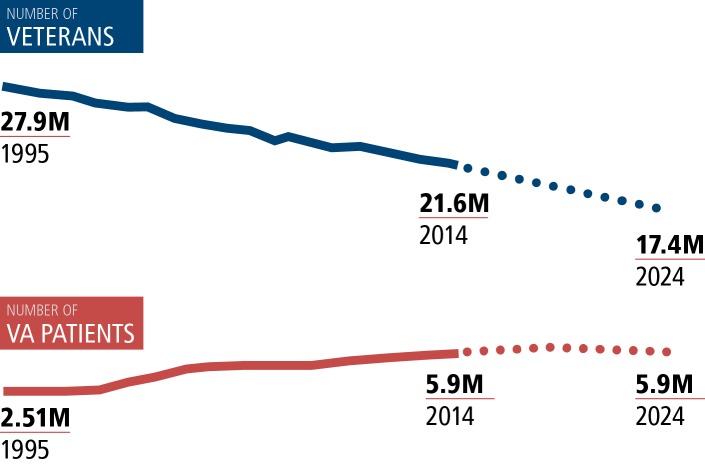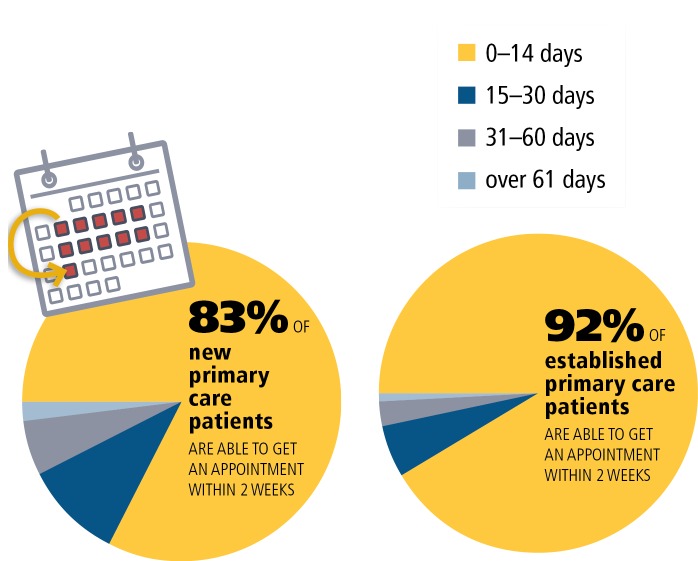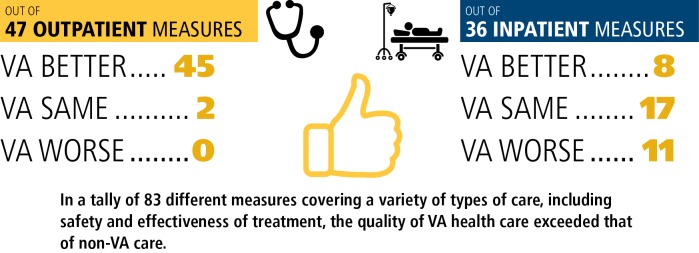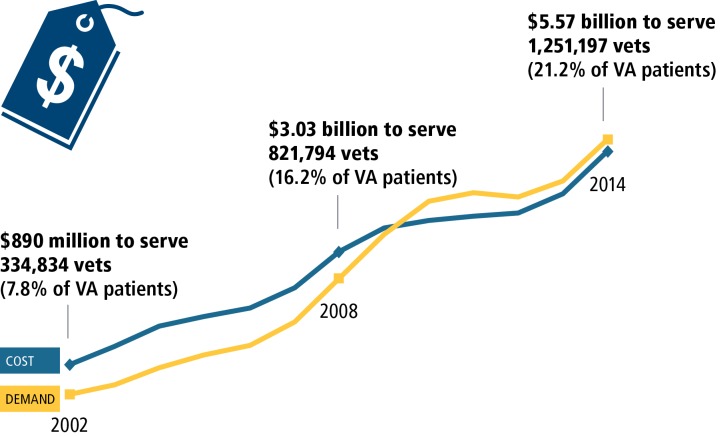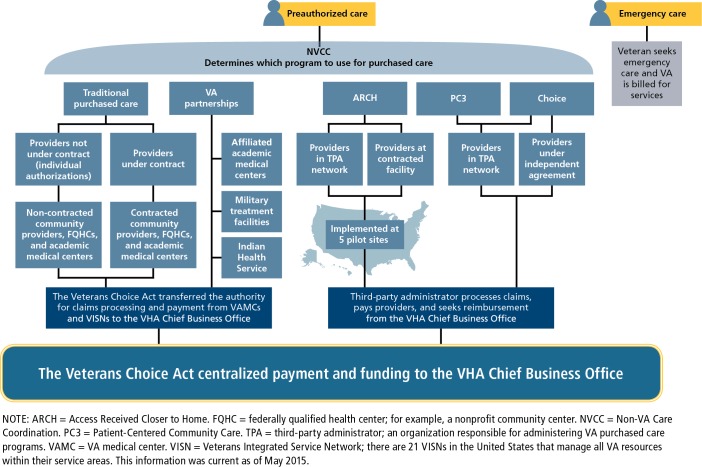Abstract
In response to concerns that the Department of Veterans Affairs (VA) has faced about veterans' access to care and the quality of care delivered, Congress enacted the Veterans Access, Choice, and Accountability Act of 2014 (“Veterans Choice Act”) in August 2014. The law was passed to help address access issues by expanding the criteria through which veterans can seek care from civilian providers. In addition, the law called for a series of independent assessments of the VA health care system across a broad array of topics related to the delivery of health care services to veterans in VA-owned and -operated facilities, as well as those under contract to VA.
RAND conducted three of these assessments: Veteran demographics and health care needs (A), VA health care capabilities (B), and VA authorities and mechanisms for purchasing care (C).
This article summarizes the findings of our assessments and includes recommendations from the reports for improving the match between veterans' needs and VA's capabilities, including VA's ability to purchase necessary care from the private sector.
Key Findings from Across RAND's Three Assessments
The three-decade decline in the number of veterans will continue. The total number of veterans is expected to decrease by 19 percent between 2014 and 2024, assuming no major policy changes or large-scale conflicts. The median age of this population will continue to increase, and veterans are projected to become more geographically concentrated over this period.
Veterans who use VA for health care are typically older and sicker than other veterans; however, veterans who rely most on VA care tend to be younger and poorer and to live in rural areas and lack health care from other sources.
Through 2019, the demand for VA services may outpace supply. From 2020 and onward, demand for VA care will level off or decline, barring any major conflicts or changes in eligibility policy.
We observed considerable variability in access to care and found opportunities to improve access, even at the top-performing VA facilities. Some veterans face barriers to accessing VA health care in a timely manner, especially in a number of key specialties.
Quality of care delivered by VA is generally equal to or better than care delivered in the private sector, though there is considerable variation across centers and types of care.
VA has stepped up the purchase of care from the private sector, though its purchased care programs currently lack an overarching strategy and little is known about the timeliness and quality of the care.
Congress may need to revise VA's authority to purchase outside care, depending on the strategy adopted for purchased care.
Introduction
U.S. veterans represent a special population of men and women who have served their country, many facing extraordinary health risks during their deployments. Because many veterans have served on overseas missions, including combat, veterans with service-connected health issues are a clinically complex and potentially vulnerable population. The mission of the Department of Veterans Affairs (VA) health care system is to meet the health care needs of this population.
However, in recent years VA has faced increasing concerns about veterans' access to care and the quality of care delivered. In February 2014, in a widely publicized episode, a retired VA physician alleged that at least 40 veterans died while waiting for care at the Phoenix VA Health Care System. The allegations of deaths were not proven, but they emerged amid wider allegations of long wait times at VA medical centers, poor patient outcomes, and other systemic issues in the VA health care system.
In response to these concerns, the Veterans Access, Choice, and Accountability Act of 2014 (“Veterans Choice Act”) was enacted in August 2014. The law attempted to address access issues by expanding the criteria through which veterans can seek care from civilian providers. In addition, the law called for a series of independent assessments of the VA health care system across a broad array of topics related to the delivery of health care services to veterans in VA-owned and -operated facilities, as well as those under contract to VA.
RAND conducted three of these assessments.
This article summarizes the findings of our assessments and makes recommendations for improving the match between veterans' needs and VA's capabilities, including VA's ability to purchase necessary care from the private sector.
Specifically, RAND teams examined:
The current and projected characteristics and unique health care needs of veterans
VA's current and projected health care capabilities and resources for meeting veterans' needs
The authorities and mechanisms under which VA can purchase care from the private sector
Demand: How Much Care Do Veterans Use?
Assessing the demand for care among the population VA serves is challenging. Under current policy, about 60 percent of U.S. veterans are eligible for VA care, based on length of service, service-connected injuries, service in designated combat theaters, and income. Fewer than half of eligible veterans use VA health benefits. Most veterans who use VA care have other sources of coverage, such as Medicare or private insurance, and rely on those other sources of care for some of their health care needs. Thus, demand for VA health services is driven largely by eligible veterans' health care needs and the extent to which they seek care from VA instead of other sources.
Veteran Demographics Are Changing
Since 1980, the size of the U.S. veteran population has declined by 21 percent. At the same time, the number of veterans using VA health care has increased substantially. The increase is largely due to expanded eligibility and greater reliance on VA health care by recent cohorts of veterans.
Our analysis looked at how these trends will evolve through 2024 (Figure 1). We project that the veteran population will decrease by 19 percent from 2014 levels. In the near term—through 2019—the number of veterans using VA health care will increase. However, this growth in demand will level off or decline beginning in 2020, due to the end of the wars in Iraq and Afghanistan and the continuing decrease in the veteran population. Demand could increase again if eligibility is expanded, access to care improves, or there is a future conflict.
Figure 1.
Despite a Shrinking Population of Veterans, the Number of Veterans Who Use VA for Health Care Will Increase Until 2019, Then Level Off or Decline
VA Serves Veterans with More-Complex Health Needs
Compared with non-veterans, veterans are disproportionately older, male, and less healthy. Veterans who use VA health care—VA patients—are typically older than other veterans. More than half—52 percent—are over age 65, compared with 39 percent of veterans who are not VA patients. VA patients are also more likely than other veterans to have been deployed. Partly as a result of their older age and deployment experience, VA patients have a higher prevalence of chronic physical and mental health conditions than other veterans. For example, rates of cancer, diabetes, and mental health conditions are higher for VA patients than for veterans who do not use VA (Figure 2). These differences also reflect the eligibility criteria for enrolling in VA care, which depend in part on health status.
Figure 2.

VA Patients Have a Higher Prevalence of Serious Health Conditions Than Other Veterans and Non-Veterans
The relatively high rates of these conditions for VA patients—combined with otherwise rare conditions related to combat, such as limb loss, traumatic brain injury, blindness, and severe burns—mean that VA providers handle a patient mix that differs from what most community providers typically see.
VA Patients Who Rely Most on VA for Care Are Younger and Lack Other Sources of Coverage
Most VA patients receive only a portion of their health care from VA. The extent to which veterans use care from VA is captured in the concept of reliance, defined as the fraction of care delivered or paid by VA. We estimated reliance using data from both VA and outside sources, which allowed us to view VA and non-VA health care use concurrently.
Certain groups of VA patients rely more heavily on VA for health care. Lower-income veterans, veterans in rural areas, veterans without other sources of coverage, and veterans with poorer self-reported health status get a higher fraction of their medical care from VA than other VA patients do. And although, as a group, VA patients tend to be older than other veterans, those who rely most on VA for their health care are younger.
We also found that the mix of VA and non-VA use varies by type of care, but in general, VA patients get more than half of their care through non-VA sources (Figure 3). In particular, VA patients rely most on VA for prescription drug benefits and inpatient visits associated with surgery. Even for these services, however, VA provides less than half of the care used by veterans.
Figure 3.

VA Patients Rely on VA for Only a Part of Their Health Care
Demand for VA Care Will Evolve by 2024
This picture will change in the decade between 2014 and 2024, in the following ways.
The VA patient population will become less healthy. Owing partly to aging and the increasing share of Iraq and Afghanistan veterans, the future VA patient population will have a higher prevalence of chronic conditions (such as diabetes and hypertension) and mental health conditions (such as depression and posttraumatic stress disorder).
However, the overall health status of new veterans will improve over time (barring another major conflict) because of the increase in the share of separating service members who did not face deployment-related health injuries. However, this will not be enough to offset the general downward trend in the health of the VA patient population as a whole.
Understanding future demand for health care among veterans who served in Iraq or Afghanistan is critical to meeting their needs. By 2024, about 19 percent of VA patients will have served in Iraq or Afghanistan (compared with 12 percent in 2014). The long-term health impacts of deployment in these conflicts are not yet well understood, and therefore this cohort may pose new challenges for the VA health system.
A future conflict would increase demand for VA services. U.S. engagement in a military conflict in the next ten years would increase the number of newly eligible veterans, many of whom would have combat exposure. Across a range of conflict scenarios of different levels of scale and intensity, our analysis predicted that a future conflict would add between 500,000 and 925,000 new VA patients.
Geographic shifts will also influence demand for care. As the veteran population continues to shift to the south and west, there will be substantially fewer veterans in some areas in the northeast and upper Midwest (Figure 4).
Figure 4.
As the Veteran Population Continues to Shift to the South and West, There Will Be Substantially Fewer Veterans in Some Areas in the Northeast and Upper Midwest
Supply: What Is VA's Capacity to Deliver Health Care and How Might This Impact Veterans' Access?
VA operates one of the most extensive health care systems in the country, with broad and deep resources and capabilities, including 144 hospitals, 700 outpatient clinics, and more than 55,000 employed clinicians. However, VA's ability to harness these resources effectively to meet the health care needs of veterans has been called into question.
VA's Capacity to Meet Demand
We assessed VA's current capacity to meet demand based on measures of access and quality.
Most veterans live near a VA health care facility. Although veterans are highly dispersed throughout the United States, 93 percent of veterans live within 40 miles' driving distance of a VA health care facility. However, geographic access to VA care varies by how access is measured (e.g., driving distance, driving time, public transit time) and what services are needed (Figure 5). For example, veterans who rely on public transportation face a significant barrier to access: Only 25 percent of veterans live within a 60-minute transit time from a VA medical facility. Further, fewer veterans have geographic access to advanced and specialized services in VA facilities. For example, only 43 percent of veterans live within 40 miles of VA interventional cardiology services, and only 55 percent of veterans live within 40 miles of VA oncology services.
Figure 5.
Nearly All Veterans Live Within a 40-Mile Drive to a VA Health Care Facility; Far Fewer Have Easy Access to VA Facilities Via Public Transit
VA Usually, but Not Always, Provides Timely Care
According to VA data, most veterans get care within two weeks of their preferred appointment date (that is, the date that the physician recommends or that the veteran prefers), as shown in Figure 6, and the vast majority complete their appointments with their primary care providers within the VA timeliness standard of 30 days from the preferred date. This pattern persists for specialty care as well, with access to mental health care slightly better.
Figure 6.
Most Veterans Get Care Within Two Weeks of Their Desired Appointment Date
However, the average number of days that veterans wait for appointments varies tremendously across VA facilities, with some patients not completing their appointments until more than 60 days after their preferred date. Only about half of veterans reported getting care “as soon as needed.” The wait time measure used by VA (number of days following the preferred date) makes it difficult to compare it with other health systems. Many private-sector entities use different strategies to capture the timeliness of care, such as the proportion of facilities that are able to offer a same-day appointment, or the average number of days from the current date until the third-next-available appointment.
In the Near Future, Demand for VA Care Is Expected to Exceed Capacity
As noted earlier, demand for VA care is expected to increase through 2019 before leveling off in 2020. In particular, demand for specific types of care—including pain medicine, neurology, dermatology, and many others—is expected to grow. Overall, the near-term increase in demand for care may outpace VA's capacity to provide timely care to all veterans.
VA Provides Higher-Quality Health Care Than Non-VA Care Sources on Many Measures
VA established itself as a leader in quality-of-care measurement and improvement in the 1990s, and, overall, quality-of-care delivered today compares favorably with that of comparable civilian facilities, though it falls short on some measures and in some facilities. For example, while VA outpatient care outperformed non-VA outpatient care on most quality measures, VA performance on measures of inpatient care was mixed, with some better and others worse (Figure 7). Our analysis also found wide variation across VA facilities in performance on many quality measures.
Figure 7.
VA Outpatient Care Outperformed Non-VA Outpatient Care on Most Quality Measures; VA Performance on Measures of Inpatient Care Was Mixed, with Some Better and Others Worse
What Should Policymakers Consider When Examining Changes to Purchased Care?
Use of Purchased Care Has Been Growing
In recent years, VA has increased its purchases of care from private-sector providers to accommodate veterans whose needs cannot be met in-house. The Veterans Health Administration's (VHA's) Chief Business Office estimated that VA purchased care costs in fiscal year 2014 totaled $5.6 billion (9.4% of VA's medical expenditures) after steady and significant increases year after year, as shown in Figure 8. The Veterans Choice Act added another $10 billion to VA's budget to expand purchased care in 2015–2017.
Figure 8.
Cost and Demand for Purchased Care Have Increased Almost Three-Fold Over the Past Decade, and This Trend Will Likely Continue
The Veterans Choice Act also expanded eligibility for veterans who are already eligible for VA health care to purchase care outside of VA. Veterans can obtain an appointment with an outside provider under the Choice program if they live far from the health care they need or if they are unable to schedule an appointment at a VA hospital or other VA facility within VA's 30-day standard.
VA's Purchased Care System Is Complex
At the time of our analysis, VA purchased outside care through various mechanisms, each guided by different structures, policies, and procedures, as shown in Figure 9. We found that decisions about which purchased care mechanism to use for a particular circumstance relied on the complex judgment of VA administrators–with priority given to VA partner facilities overseen by other federal agencies or affiliated academic institutions. Beyond that, referral decisions took into account other factors, such as payment levels and provider qualifications.
Figure 9.
VA Purchased Care Evolved in an Unsystematic Fashion
Our analysis identified a number of inconsistencies in how purchased care was administered, how referrals were made, and how claims and payments to providers were handled. It also uncovered inconsistent procedures for purchased care decisions at the local level. For example, one local VA facility might purchase a specific medical service as part of a larger contract for a bundle of services, while another facility purchases the same service under a separate, small contract that is subject to different levels of oversight. In July 2015 (after this assessment was completed), Congress passed new legislation requiring VA to develop a plan to consolidate its purchased care function.
Purchased Care Quality and Timeliness Are Unknown
Although increasing the use of purchased care has been suggested as a way to increase veterans' access to care, our analysis found that most veterans who live far from a VA facility live near private-sector primary care but not specialty care. In addition, the quality and timeliness of the care VA purchases relative to VA care are unknown. Currently, VA does not monitor the quality of care provided by outside entities or track how long it takes for veterans to receive such care.
VA Lacks a Clear Strategy for Purchased Care
Our analysis of VA's purchased care authorities found inherent tensions in the goals of purchased care, reflecting uncertainty about the extent to which policymakers may wish to preserve VA's primary function as a health care provider or allow VA to provide more care through the private sector. Policy-makers must decide on a clear strategy for purchased care before making further changes: Should purchased care be used to fill gaps and provide a quick response when there are spikes in demand, or is there a longer-term vision for shifting the delivery of care away from brick-and-mortar VA facilities as the demographics of the veteran population change? Possible policy objectives that could prompt such changes are explored at the end of this section.
Given the many possible objectives for the future of purchased care, VA and Congress could find themselves considering a range of changes to how and under what conditions VA purchases care. These changes could include enhancing relationships with private providers, modifying the eligibility requirements for purchased care, changing how purchased care is managed, and improving contracting for purchased care.
Possible Objectives for Purchased Care
Address short-term gaps in VA health care capacity through a temporary surge in purchased care. “Short-term gaps” could be those that exist today (i.e., in the timeliness of appointments), or they could involve a future mismatch between VA resources and demand for specialty care.
Address long-term gaps in VA health care capacity through the use of purchased care permanently. Gaps could arise in any aspect of VA health care service capacity that cannot be filled feasibly or efficiently by VA capacity development.
Improve the value of health care for Veterans through purchased care. From the perspective of government, purchased care could be provided where doing so would lead to improvements in such areas as clinical quality of care or cost-effectiveness.
Expand or enhance purchased care to increase Veterans' choices. Veterans could be offered more choice to seek coverage and care outside of the traditional VHA system (e.g., via private providers or other government facilities, such as those run by the Department of Defense).
Redefine the concept of VA health care by aggressively outsourcing VA care. The nature of VA health care activities could be transformed by making purchased care much more focal as a primary mechanism for delivering specific health care services to veterans or for delivering health care services to specific groups of veterans.
Recommendations
The following recommendations from across the three assessments point toward solutions that policymakers and VA should consider in progressing toward the goal of providing high-quality, timely, and accessible health care that meets veterans' needs.
1. Prepare for a Changing Veteran Landscape
Balance the need for short-term capacity increases with longer-term preparations for declines in patient numbers.
Over the past decade, VA has faced a steady increase in demand for health care. While we found that this trend will continue in the near term, VA must prepare for a decline in the size of the patient population over the longer term. If VA responds to current increases in demand by expanding facilities, infrastructure, staffing, and other resources, the result may be a larger-than-needed footprint after 2019, when the patient population begins to level off.
Assess the best way to provide care in different areas of the country and for different types of care.
The challenges facing VA will be more acute in some regions and at some VA facilities than others, so considerations of distribution will be as important as consideration of overall levels. In regions where the site of the veteran population is expected to decline more sharply, VA might consider consolidating relatively proximal VA facilities, while in regions with projected veteran population growth, there may be a need to expand the availability of VA health care. Increasing the use of care purchased from the civilian sector may enable VA to meet the needs of veterans in regions with expected growth or few existing facilities. In other regions, care may more efficiently be delivered through telemedicine and community-based outpatient clinics.
Improve and expand data collection to inform estimates and planning for future demand of VA care.
Re-implement data collection on veteran status in the 2020 Census. The most comprehensive source of information on veterans is the 2000 U.S. Census, meaning that comprehensive information is now 15 years old. The 2010 Census did not collect data on veteran status, and current efforts to study the veteran population rely on surveys of samples of the population that are less accurate.
Closely monitor the needs of post-9/11 veterans. Post-9/11 veterans may have different patterns of VA health care use than earlier generations of veterans. New policies have been established to address the needs of the large number of veterans who were exposed to combat over the long duration of the post-9/11 conflicts. Closely monitoring the health care needs of this new generation of veterans will ensure that VA can respond rapidly and appropriately to their needs.
Collect better data on all health care used by veterans. Little is known about the health care use and needs of veterans who receive some or all of their care outside VA. Data on the care used by these veterans, as well as their unmet needs for care, would allow VA to identify how best to serve the evolving needs of this group. Such data also would enable VA to better plan for future changes in VA eligibility rules or enrollment patterns.
2. Improve Access and Quality
Take significant steps to improve access to VA care.
Adjustments to VA's resources and capabilities will be needed to meet the near-term demand for health services among veterans. We identified several policy options to ensure that veterans have continued access to care; those that have the highest potential impact include the following:
Increase the number of VA physicians to expand the number of patients who can be seen in a timely manner.
Formalize independent nursing practice, granting independent practice authority for all advanced-practice nurses (i.e., nurse practitioners, clinical nurse specialists, nurse anesthetists, and nurse midwives) across VA.
Expand virtual access to care (e.g., use of clinical video telehealth) to increase access to clinical care when distance separates the patient and provider.
These options are not mutually exclusive, and each has different potential barriers to implementation. For example, the primary barrier to formalizing independent nursing practice is political (key stakeholder opposition); the barriers to hiring physicians are related to cost and administrative challenges associated with the hiring process; and the primary barrier to expanding virtual access to care is cost.
Reduce variability in access and quality to ensure all veterans receive timely, high-quality care.
Although many VA facilities achieve very high levels of performance on key access and quality measures, there is also a great deal of variation across the system in strategies used to achieve high performance. A systematic, continuous performance improvement effort is needed to identify unwarranted variation, identify and develop best practices to improve performance, and embed these practices into routine use across the VA system.
Consider alternative standards of timely access to care.
VA should examine the utility of alternative benchmarks of timeliness, such as those related to appointment availability. VA should develop methods to routinely compare the timeliness of VA care with non-VA benchmarks and publish these comparisons for transparency.
Develop and implement more-sensitive standards of geographic access to care.
VA and Congress should compare the “one-size-fits-all” approach of driving distance with alternative standards that are more sensitive to differences between veteran subgroups, clinical populations, geographic regions, and individual facilities. Our assessment highlighted the importance of time spent driving, mode of transportation, traffic, and availability of needed services as key considerations in assessing geographic access to care.
3. Make Strategic Use of Purchased Care
Define a strategy for purchased care.
Policymakers and VA should articulate a clear strategy and set of goals for how purchased care should be used and how it fits into VA's broader health care mission. The strategy should also establish benchmarks for success in adopting purchased care reforms. Specifically, it should provide a solid foundation for purchased care authorities and procedures going forward while maintaining the flexibility to meet surges in demand and provide veteran-centered care.
Streamline management of the current purchased care system.
As VA and Congress work toward a consolidated approach to purchasing care, our assessment recommended a review of the purchased care management structure to ensure that responsibilities like contracts and referrals are allocated to the appropriate levels within the agency. Candidates for greater oversight and streamlining include processes for evaluating the third-party administrators that operate VA's purchased care provider network and clearer, more-uniform policies for billing, episodes of care, and reporting requirements. VA should also adopt a coherent, cost-effective strategy for provider reimbursement. Policymakers will want to ensure that any changes maintain an appropriate amount of flexibility at the local level.
Monitor the quality and timeliness of care purchased outside VA.
VA is a leader in quality-of-care measurement and improvement, yet it has limited visibility into the quality and timeliness of care provided to veterans from outside entities. VA should require routine reporting of quality measures to ensure that the quality and timeliness of care that veterans receive from non-VA providers is as good as or better than the care offered by VA. Purchased care contracts should also make explicit how non-VA providers will communicate and coordinate with VA counterparts.
Footnotes
The analyses upon which this publication is based were performed under a contract for the Department of Veterans Affairs and conducted by RAND Health, a division of the RAND Corporation. The development and production of this summary was funded through a generous philanthropic gift from Charles Zwick.



